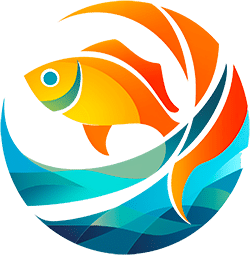Sometimes it's hard to find your way between aquaculture and fish farming, especially when your customers want to know more about them in your pet shop. But don't panic, I'm here to help you make sense of it all.
Quality signs in the fish farming sector
To fully understand the difference between aquaculture and fish farming, it is essential to look at the signs of quality in the fish farming sector. In France, a number of labels and certifications guarantee consumers that their fish is produced in a way that respects the environment and health standards.
The main signs of quality include :
- Label Rouge : This label is awarded to species such as turbot, sea bass and sea bream. It is synonymous with superior quality in terms of taste and production methods.
- Organic aquaculture : It applies to fish such as sea bass, sea bream, meagre, trout and prawns. This certification guarantees the absence of GMOs and chemical products during farming.
These certifications help to reassure consumers about the quality of our products. Organic and environmentally-friendly practices are becoming increasingly popular, especially with the rise in environmental concerns.
Production and consumption trends in the fish farming sector
France's fish farming sector stands out for its diversity and its efforts to meet environmental requirements. As far as salmon farming is concerned, rainbow trout remains the most widely produced species, with production exceeding 32,000 tonnes a year. However, the sector saw a 20 % drop in production and the number of farms between 1997 and 2007, partly as a result of the Water Framework Directive (WFD).
The picture is similar for marine fish farming. Introduced in the 1970s, it produced around 5,200 tonnes in 2013, concentrated around a few main species such as sea bass and gilthead bream. However, competition with other coastal activities and the scarcity of available sites have curbed its expansion.
- Sea bass and gilthead bream account for a large proportion of production.
- Its main species also include turbot, salmon, sea trout and meagre.
France's overseas territories are also contributing to the sector, with the development of ocellated umbra farming. Production and exports of marine fish fry and larvae have tripled in ten years, reinforcing France's position as a major producer in Europe.

The differences between hydroponics and aquaponics :
Today, many of your customers are interested in more ecological and autonomous systems, such as hydroponics and aquaponics. But how do you distinguish between the two?
Hydroponics is a method of growing plants above ground. which uses a nutrient solution to supply the plants. Here are some of its main features:
- Use of a nutrient-rich fertiliser solution.
- Quick start-up for more immediate production.
- More expensive nutrients over the long term.
Aquaponics integrates fish farming into the system. Fish droppings provide the nutrients needed by plants after a nitrification stage. A truly bio-integrated ecosystem! Its strengths include :
- Use of fish waste as a natural fertiliser.
- Imperative need for bacteria to transform waste into nutrients.
- More cycles and natural regeneration.
- Easier maintenance and a sustainable ecosystem.
In terms of productivity, aquaponics often has the edge, thanks to faster, more efficient plant growth.
See also
When I wander around the shelves of our pet shop, I often notice that few people know that pond fish farming is a traditional activity that is in sharp decline. Producing around 8,000 tonnes a year, it plays a vital role in restocking fish stocks and direct consumption. However, it faces challenges such as predation by cormorants and the threat of closure in some regions.
| Type of fish farm | Features |
|---|---|
| Salmon farming | Rainbow trout, declining production, environmental requirements. |
| Marine fish farming | Sea bass, sea bream, stagnating production. |
| Pond fish farming | Traditional production, environmental challenges. |
Even with these challenges, France remains one of the world leaders in fish farming and continues to evolve in response to new consumer expectations. As aquaponics and hydroponics gain ground, practices need to adapt, and it will be exciting to see how this sector evolves over the coming years.
Finally, for aficionados of luxury products, did you know that France also produces caviar? With almost 20 tonnes a year, it ranks third in the world. Mainly concentrated in Aquitaine, production is based on breeding the sturgeon Acipenser baeri. In 2007, four companies accounted for 81 % of sales in this sector.
